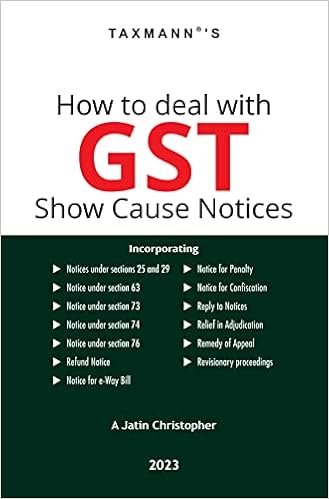Taxmann’s How to Deal with GST Show Cause Notices – Demonstrates how to deal with GST SCNs with the help of various do’s & don’ts, checklists, visualizations, templatized answers, etc.

Buy online Click here
This book effectively demonstrates how to deal with various types of GST Show Cause Notices. The author showcases solutions to the mistakes committed over the years of his litigation practice.
The Present Publication is the Latest Edition, authored by A Jatin Christopher, with the following noteworthy features:
- [Do’s & Don’ts while Replying to Notices] that are extensively illustrated with hypothetical facts
- [Checklists, Visualizations & Templatized Answers] are included in this book to share experiences gathered in a short period since the introduction of GST to
- [Suggestions for Additional Reading & Reference] are made in this book to help the reader extend their study of the subject matter
- [Simplistic Language] that revolves in & around the statutory provisions, without repeating the bare provisions of the statute
The structure of the book is as follows:
- The first chapter provides background to the following:
o Study of the topic of notices
o Prevailing jurisprudence
o Importance of a deep study of this topic to better equip readers to respond to notices that are being issued with a feverish pace - From the second to the tenth chapter is a sequential deliberation on the divergent kinds of ‘notices’ that are prescribed in this new law and the essential goals forming the pith of this pursuit
- The eleventh chapter pays special attention to the following:
o ‘Preparation’ that is needed before launching into drafting the reply (to notices)
o Cautions against over-enthusiastic uncovering of the truth that may not even be the basis for the allegations in the notice - The twelfth chapter exposes the rights, remedies, and safeguards available in the law in a non-traditional manner of reading the statutory provisions. This manner of presentation keeps the touch points relevant to replying without following the order in which provisions are presented in the statute
- The thirteenth chapter is where the whole of the deliberations up to this point are primed to deliver and present a structured approach to the actual reply. Examples are relied upon liberally to avoid excessive textual deliberation. After all, a lesson caught is better than a lesson taught’
- The fourteenth and fifteenth chapters show what can be achieved in adjudication so that it illuminates the key considerations discussed in earlier chapters about ‘replying to notices’ and exposes the likely response (in adjudication) of the grounds urged in the reply. It also shows grounds that could possibly be denied consideration and some that could even attract adverse conclusions.
- The sixteenth and seventeenth chapter shows how a reply (to notice) which is of high quality can be greatly appreciated in appeal so that it offers perspective to refine the pleadings right at the stage of adjudication.
- The eighteenth chapter augments the learnings from deliberations up to this point, given the curative powers perilous to the interests of the taxpayer that reside in revisionary proceedings in this law. Appreciation of this exceptional jurisdiction will offer the finest extent of refinement that replies (to notices) can be given so that nothing untoward is left, even unwittingly, in any material placed on record.
- The nineteenth chapter brings attention to additional matters of jurisprudence that taxpayers and other readers must be appraised about so that the effort so far is prudent and sets the stage for more deliberations when Appellate Tribunals are established in GST

